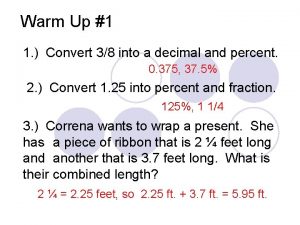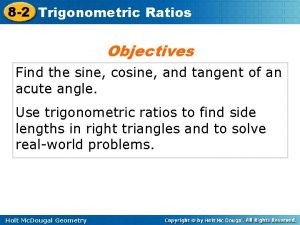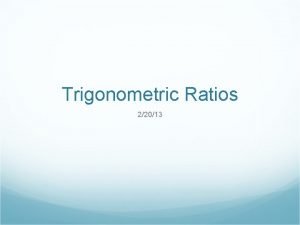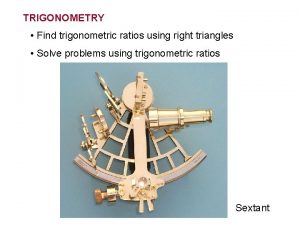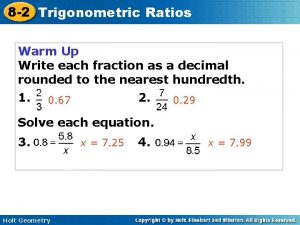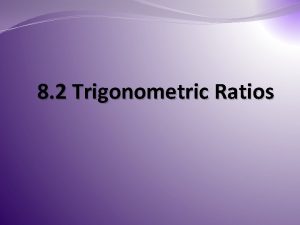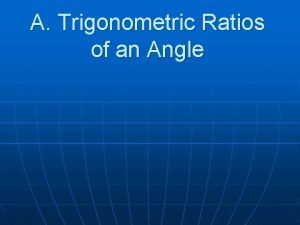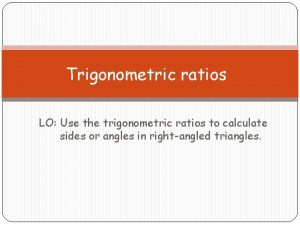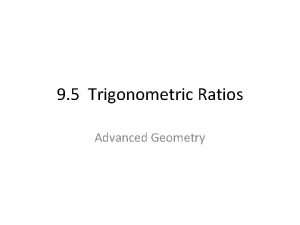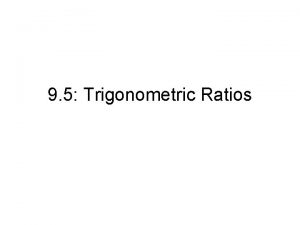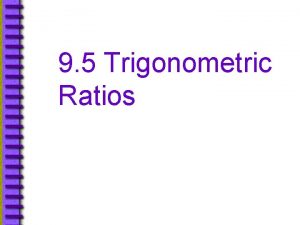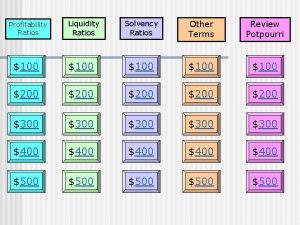Finding Trigonometric Ratios A trigonometric ratio is a













- Slides: 13

Finding Trigonometric Ratios A trigonometric ratio is a ratio of the lengths of two sides of a right triangle. The word trigonometry is derived from the ancient Greek language and means measurement of triangles. The three basic trigonometric ratios are sine, cosine, and tangent, which are abbreviated as sin, cos, and tan, respectively.

Finding Trigonometric Ratios A trigonometric ratio is a ratio of the lengths of two sides of a right triangle. TRIGONOMETRIC RATIOS Let ABC be a right triangle. The sine, the cosine, and the tangent of the acute angle A are defined as follows. B a side opposite A = sin A = c hypotenuse cos A = side adjacent A b = hypotenuse c a side opposite A tan A = = side adjacent to A b hypotenuse c A b side adjacent to A side a opposite A C The value of the trigonometric ratio depends only on the measure of the acute angle, not on the particular right triangle that is used to compute the value.

Finding Trigonometric Ratios Compare the sine, the cosine, and the tangent ratios for A in each triangle below. B SOLUTION 8. 5 By the SSS Similarity Theorem, the triangles are similar. Their corresponding sides are in proportion, which implies that the trigonometric ratios for A in each triangle are the same. 4 C A 7. 5 B 17 8 A sin A = cos A = tan A = opposite hypotenuse Large triangle 8 0. 4706 17 adjacent hypotenuse opposite adjacent 15 0. 8824 17 8 0. 5333 15 Small triangle 4 0. 4706 8. 5 7. 5 0. 8824 8. 5 4 0. 5333 7. 5 15 C Trigonometric ratios are frequently expressed as decimal approximations.

Finding Trigonometric Ratios Find the sine, the cosine, and the tangent of the indicated angle. R S 5 SOLUTION T 13 S 12 The length of the hypotenuse is 13. For S, the length of the opposite side is 5, and the length of the adjacent side is 12. opp. 5 = hyp. 13 0. 3846 R adj. 12 0. 9231 cos S = = hyp. 13 5 opp. sin S = opp. 5 0. 4167 = tan S = adj. 12 T 13 hyp. 12 adj. S

Finding Trigonometric Ratios Find the sine, the cosine, and the tangent of the indicated angle. R R 5 SOLUTION T 13 S 12 The length of the hypotenuse is 13. For R, the length of the opposite side is 12, and the length of the adjacent side is 5. sin R = opp. 12 = hyp. 13 0. 9231 adj. 5 cos R = 0. 3846 = hyp. 13 opp. 12 = tan R = = 2. 4 adj. 5 R 5 adj. T 13 hyp. 12 opp. S

Trigonometric Ratios for 45º Find the sine, the cosine, and the tangent of 45º. SOLUTION Because all such triangles are similar, you can make calculations simple by choosing 1 as the length of each leg. From the 45º-90º Triangle Theorem, it follows that the length of the hypotenuse is 2. sin 45º = cos 45º = tan 45º = opp. = hyp. adj. = hyp. opp. 1 = adj. 1 1 = 2 2 2 0. 7071 2 1 0. 7071 45º 1 =1 hyp.

Trigonometric Ratios for 30º Find the sine, the cosine, and the tangent of 30º. SOLUTION To make the calculations simple, you can choose 1 as the length of the shorter leg. From the 30º-60º-90º Triangle Theorem, it follows that the length of the longer leg is 3 and the length of the hypotenuse is 2. sin 30º = cos 30º = tan 30º = 1 opp. = = 0. 5 2 hyp. adj. = hyp. opp. = adj. 3 2 1 3 2 0. 8660 = 3 3 1 30º 0. 5774 3

Using a Calculator You can use a calculator to approximate the sine, the cosine, and the tangent of 74º. Make sure your calculator is in degree mode. The table shows some sample keystroke sequences accepted by most calculators. Sample keystroke sequences Sample calculator display Rounded approximation 74 sin or sin 74 Enter 0. 961261695 0. 9613 74 cos or cos 74 Enter 0. 275637355 0. 2756 74 tan or tan 74 Enter 3. 487414444 3. 4874

Finding Trigonometric Ratios The sine or cosine of an acute angle is always less than 1. The reason is that these trigonometric ratios involve the ratio of a leg of a right triangle to the hypotenuse. The length of a leg of a right triangle is always less than the length of its hypotenuse, so the ratio of these lengths is always less than one. Because the tangent of an acute angle involves the ratio of one leg to another leg, the tangent of an angle can be less than 1, equal to 1, or greater than 1.

Finding Trigonometric Ratios The sine or cosine of an acute angle is always less than 1. The reason is that these trigonometric ratios involve the ratio of a leg of a right triangle to the hypotenuse. The length of a leg of a right triangle is always less than the length of its hypotenuse, so the ratio of these lengths is always less than one. Because the tangent of an acute angle involves the ratio of one leg to another leg, the tangent of an angle can be less than 1, equal to 1, or greater than 1. TRIGONOMETRIC IDENTITIES A trigonometric identity is an equation involving trigonometric ratios that is true for all acute angles. The following are two examples of identities: B (sin A) 2 + (cos A) 2 = 1 tan A = sin A cos A c A a C b

Using Trigonometric Ratios in Real Life Suppose you stand look up at a point in the distance, such as the top of the tree. The angle that your line of sight makes with a line drawn horizontally is called the angle of elevation.

Indirect Measurement FORESTRY You are measuring the height of a Sitka spruce tree in Alaska. You stand 45 feet from the base of a tree. You measure the angle of elevation from a point on the ground to the top of the tree to be 59°. To estimate the height of the tree, you can write a trigonometric ratio that involves the height h and the known length of 45 feet. tan 59° = opposite adjacent Write ratio. tan 59° = opposite h adjacent 45 Substitute. 45 tan 59° = h Multiply each side by 45. 45(1. 6643) h Use a calculator or table to find tan 59°. 74. 9 h Simplify. The tree is about 75 feet tall.

Estimating a Distance ESCALATORS The escalator at the Wilshire/Vermont Metro Rail Station in Los Angeles rises 76 feet at a 30° angle. To find the distance d a person travels on the escalator stairs, you can write a trigonometric ratio that involves the hypotenuse and the known leg length of 76 feet. sin 30° = opposite hypotenuse Write ratio for sine of 30°. sin 30° = 76 opposite hypotenuse d Substitute. d sin 30° = 76 76 d= sin 30° 76 d= 0. 5 d = 152 Multiply each side by d. d 76 ft Divide each side by sin 30° Substitute 0. 5 for sin 30°. Simplify. A person travels 152 feet on the escalator stairs.
 How to solve ratio and proportion
How to solve ratio and proportion Solving problems by finding equivalent ratios
Solving problems by finding equivalent ratios How to find angle with inverse trig
How to find angle with inverse trig Finding equivalent ratios given the total quantity
Finding equivalent ratios given the total quantity Trigonometric functions in real life
Trigonometric functions in real life Intro to trigonometry worksheet
Intro to trigonometry worksheet 8-2 trigonometric ratios
8-2 trigonometric ratios Trig functions
Trig functions Sin trig
Sin trig Magic triangle trigonometry
Magic triangle trigonometry 8-2 trigonometric ratios worksheet answers
8-2 trigonometric ratios worksheet answers Derivative of inverse functions
Derivative of inverse functions Find sin x
Find sin x Trigonometric ratios of the angles
Trigonometric ratios of the angles
